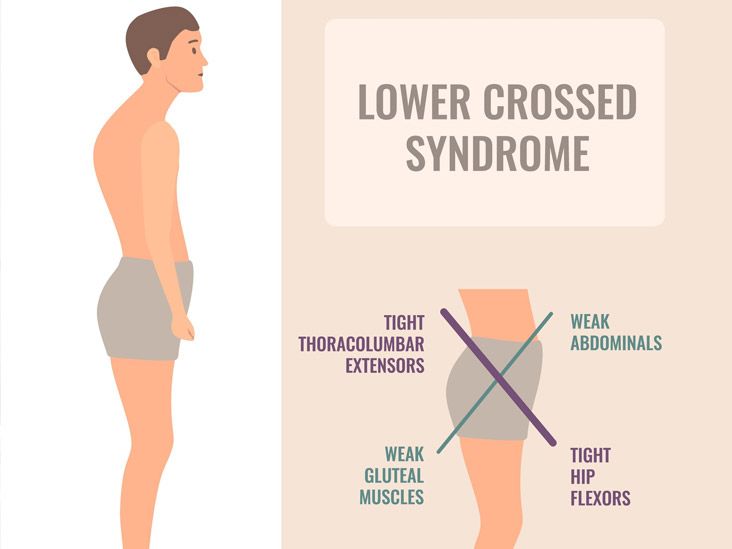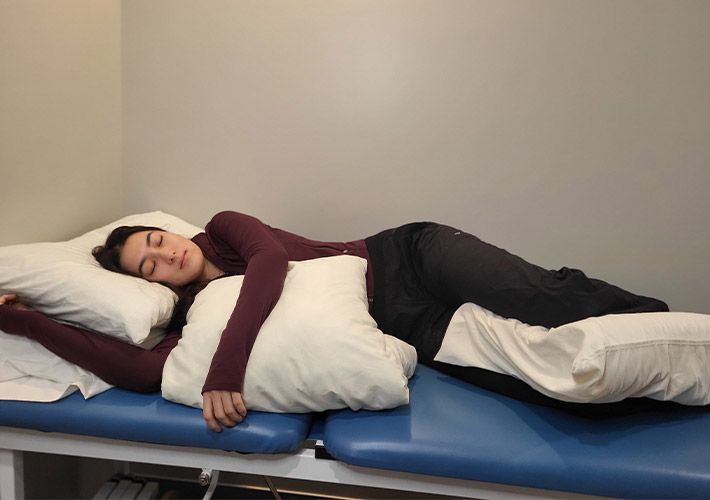Lower Cross Syndrome: What It Is and How to Fix It

If you’ve ever felt nagging lower back pain, persistent tightness in your hips, or a sense of imbalance between your core and legs, you might be dealing with something called Lower Cross Syndrome (LCS). While it sounds complex, LCS is actually a common muscular imbalance that many people—especially those with sedentary jobs or intense training routines—experience.
The good news? It’s manageable, preventable, and treatable. And Peak Performance, your local chiropractic and massage therapy team, can be part of the solution.
What Is Lower Cross Syndrome?
Lower Cross Syndrome, also known as Lumbopelvic Crossed Syndrome, is a postural imbalance that occurs when certain muscles become overly tight while others grow weak. This imbalance creates a “cross” pattern when viewed from the side: tight hip flexors and lower back muscles intersect with weak glutes and abdominal muscles. The result is an anterior pelvic tilt—a forward tipping of the pelvis—that places extra strain on the lumbar spine.
This pattern throws off alignment, reduces mobility, and can lead to discomfort or injury over time. The term “cross” refers to this diagonal interaction between tight and weak muscles:
Tight muscles (facilitated):
- Hip flexors (e.g., iliopsoas, rectus femoris)
- Lumbar erectors (lower back)
Weak muscles (inhibited):
- Gluteal muscles
- Abdominals
What Causes Lower Cross Syndrome?
The modern lifestyle is a major contributor to LCS. We spend long hours sitting—at desks, in cars, or on couches—which leads to shortened hip flexors and inactive glutes. Over time, the body adapts to this posture. Add in poor core engagement, improper lifting technique, or repetitive athletic motions, and you’ve got a recipe for dysfunction.
Common contributing factors include:
- Prolonged sitting: Sitting for extended periods keeps the hip flexors shortened and the glutes disengaged.
- Sedentary lifestyle: Lack of regular exercise weakens core and glute strength.
- Overtraining certain muscle groups: Strengthening the back or quads without balancing the posterior chain (glutes, hamstrings) and core can create imbalance.
- Poor posture: Slouching or standing with excessive lower back arching contributes to faulty alignment.
Symptoms of Lower Cross Syndrome
Because LCS affects the lower back and pelvis, symptoms often mimic other common issues. Some people may not even realize they have it until they start experiencing chronic discomfort.
Here are some red flags:
- Lower back pain or stiffness
- Tight hips and hamstrings
- Anterior pelvic tilt (exaggerated lower back curve)
- Poor core stability
- Limited range of motion in the hips
- Knee pain or strain due to compensatory movement patterns
Even if you're not currently in pain, LCS can increase the risk of injury over time—especially during activities like lifting, running, or sports.
How to Prevent Lower Cross Syndrome
Preventing Lower Cross Syndrome comes down to movement, posture awareness, and balanced strength training. Incorporating regular mobility and stability exercises into your routine can go a long way.
Try these preventive strategies:
- Get up and move: If you work at a desk, take breaks every 30–60 minutes to stand, walk, or stretch.
- Strengthen your core: Exercises like planks, dead bugs, and bird dogs help activate the deep abdominal muscles.
- Activate your glutes: Incorporate glute bridges, hip thrusts, and clamshells to engage your backside.
- Stretch tight hip flexors: Hip flexor stretches and lunging hip openers counteract prolonged sitting.
- Work on posture: Pay attention to how you sit and stand. Keep your pelvis neutral and avoid overarching your lower back.
A proactive approach can reduce the risk of developing muscular imbalances and promote long-term spinal health.
How Chiropractic Care Can Help
Chiropractic care is uniquely positioned to address both the structural and functional aspects of Lower Cross Syndrome. By restoring alignment and improving joint mobility, chiropractic adjustments help reduce the strain caused by muscular imbalance.
Here’s how your chiropractor can help:
- Pelvic and spinal adjustments: These realign the lumbar spine and pelvis, helping correct postural distortions caused by LCS.
- Functional assessments: Chiropractors can evaluate movement patterns to identify contributing muscle imbalances and asymmetries.
- Rehabilitative exercises: Customized exercise programs target weak muscles and retrain faulty movement mechanics.
- Postural coaching: Your provider may offer strategies for better posture throughout your day, especially if you work at a desk.
Chiropractic care not only addresses pain but works to correct the underlying cause, making it an effective component of LCS treatment.
The Role of Massage Therapy
While chiropractic care focuses on alignment and joint health, massage therapy helps address the soft tissue imbalances at the heart of LCS. Targeted massage can relax overactive muscles, improve circulation, and speed up recovery.
Massage techniques that benefit Lower Cross Syndrome include:
- Myofascial release: Helps loosen tight fascia surrounding the hip flexors and lumbar spine.
- Deep tissue massage: Breaks down adhesions and chronic tension in overused muscle groups.
- Trigger point therapy: Addresses pain points in the lower back and hips that can refer pain elsewhere.
- Sports massage:
Supports active individuals by enhancing flexibility and promoting muscle balance.
Massage therapists can also provide insight into at-home stretches and self-care techniques to maintain muscle length and function between sessions.
Why Treating Lower Cross Syndrome Matters
Ignoring Lower Cross Syndrome can lead to more serious issues over time, such as herniated discs, sciatica, or chronic back pain. And because this syndrome often starts subtly, many people brush off the symptoms as "normal stiffness" or "just getting older."
The reality is, these imbalances can—and should—be corrected before they turn into long-term problems. By combining chiropractic care, massage therapy, and focused corrective exercises, you can restore balance to your body, improve posture, and move with less pain.
Final Thoughts
Lower Cross Syndrome is incredibly common—but that doesn’t mean it’s something you have to live with. Whether you’re an athlete, a desk worker, or somewhere in between, LCS can sneak up on anyone. The key is early detection, consistent movement, and seeking professional help when needed.
At Peak Performance, our team of chiropractors and massage therapists in Buffalo, NY, work together to address the root cause of musculoskeletal dysfunction. If you’ve been dealing with lower back pain, hip tightness, or poor posture, we’re here to help you move better, feel better, and get back to doing what you love.
Book your appointment today and let’s start restoring balance from the ground up.
Bethany Wolcott
D’Youville Chiropractic ‘26












